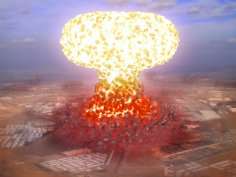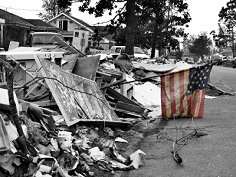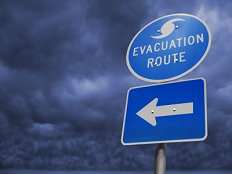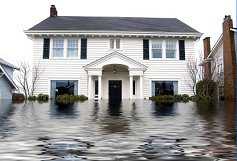







Your car emergency kit should include a mid-sized backpack stocked with non-perishable food, water, and several essential emergency supplies, as well as a few more specific items we detail below.
If you commute to work in a major city, there's a good chance that if disaster strikes, such as an earthquake, series of tornados, or something possibly truly catastrophic, it could very easily happen during the week, while you're at work. What this means is that traffic throughout the cities and suburbs is very likely going to come to a halt. If this happens, you may have to ditch your car and flee the city on foot.
That's why it's important to be prepared for this exact situation, and have a fully stocked backpack stored in the trunk of your car, complete with a detailed city map and a detailed state map so that you can find your way home.
City Map
Don't count on your GPS working for you; in the worst emergencies, satellites can be down, electricity can be out, or your phone may stop working or your car's electrical system can be fried. Always carry a detailed street map of any city that you commute to or from because one day you may need it in order to get home or to get away from a dangerous area.
State Map
A state map is a must have for evacuation purposes. Knowing how to find county roads and forest service roads can allow multiple ways to evacuate a region that has been struck by a major disaster. In the worst disasters, freeways and highways may not be in operation, or be bogged down with hundreds of thousands (possibly millions) of evacuees.
First Aid Kit
Band aids (large and small), rubbing alcohol, antibiotic ointment, tweezers, tourniquet, gauze, surgical tape, needle and thread (for emergency suturing), arm sling, etc.
Folding Knife
A good folding knife should be kept either in your front pocket (called a pocket knife) or within arms reach of the driver. If you're in an accident, your folding knife can cut through your seat belt though a seat belt cutter may be easier to use for some.
3 Days of Food
In your vehicle, carry 3 days worth of non-perishable food that is not effected by temperatures. (If you live in a hot climate, the heat can shorten the lifespan of your food; if you live in a cold climate, the repeated freezing and thawing of your food can also shorten it's life span.) Keep track of expiration dates and replace expiring food with new purchases every few months.
Emergency Drinking Water with 5 Year Life Span - Not only should you carry an emergency water filter, but you should also carry 3 days (or more) worth of water. If you only have an emergency water filter on hand, there is a chance that in a disaster there will be no safe sources of water nearby (lakes, rivers, or ponds for example). In a major city (or near an area of widespread agriculture or industry), avoid drinking water from nearby lakes, ponds, and streams using a water filter due to the possible contamination of sewage or industrial chemicals that can spill into underground water systems (both natural and man made). Even the best water filters should not be trusted when it comes to sewage or industrial chemicals. Mainstay provides emergency water supplies with these pouches that have a 5 year life span. (This 30 day supply for one person can be divided among several people to provide 3 days of drinking water for each.)
Eye / Lung protection
Some disasters will send plumes of smoke and dust into the air, which can sting your eyes and be harmful to breathe. Safety goggles and an approved respirator mask like this 3M dust respirator (N95 safety rating) can help you breathe and protect you from breathing in dust and particle debris.
Backpack
As mentioned above, you may need to abandon your vehicle if traffic is not moving (or if roads or bridges are destroyed). With that in mind, keep a midsize back pack (called a "Get Home Bag") packed in your vehicle with the following supplies:
Compass
If you don't know how to use a compass, learn how to use one! Understanding declination helps you differentiate between magnetic north and true north". And if one day you forget how "declination" works one day in months ahead, your compass can still be an effective tool to keep you going in the general direction (though it won't be exact and after several miles you can veer off course a bit).
Energy Bars
Choose a healthy version with a high calorie count and longer expiration date.
Beef Jerky
Dried meat (called "jerky") is a proven survival food going back to the days of the Native Americans and other primitive tribes. When choosing jerky, look for "natural" products that have no additives, MSG, etc.
Caffeine Pills
Depending on the severity of the disaster, you may need to travel for several hours at a brisk pace without having a safe place to sleep. Caffeine can help you stay awake and alert longer than if you didn't have any. There's a reason that coffee is such a popular morning drink with young and old alike. It works!
Electrolyte Tablets
Key electrolytes like magnesium, calcium, sodium, and potassium can run low during times of heavy stress or exertion, leading to fatigue, cramps, or worse -- a medical emergency. Electrolyte tablets are considered such an important item that they are included in Navy Seal survival kits.
Flashlight / Headlamp
While a flashlight has it's uses, a headlamp may be better choice because it offers hands-free use, allowing you to use both your hands, whether that's for cooking, building shelter, or crossing through an area of dense brush or trees.
Paracord
Paracord doesn't take up much space and can have multiple uses; make emergency slings, tether together a shelter, etc.
Clothing
Keep a couple outfits, including heavier weight pants and a sweatshirt and a windbreaker or outer rain shell as well as a beanie cap, wool socks, and wool mittens. Choose non-cotton materials as cotton loses all insulating properties if it gets wet and wet cotton clothing is a fast way to hypothermia. Worn in layers with the clothing you already have on that day, this non-cotton (nylon, polyester, fleece, etc.) outfit (or even two extra outfits if you can manage to pack a spare set) should help you get through somewhat cold temperatures that you encounter in the late evening hours.
Sleeping Bag / Bivy Sack (Choose an appropriate sleeping bag based on climate conditions) - If the possibility exists for freezing temperatures, you should be equipped also with a cold weather sleeping bag and waterproof bivy sack (which is an outer shell that zips around your sleeping bag, providing a wind block and protecting you from rain or melting snow).
2 - 5 Bic Lighters - A good Bic lighter can help you with fire starting (as long as you have dry tinder to work with). If tinder is damp, use an emergency candle to dry your tinder out (cut the top off an empty soda can, fill the bottom with damp tinder, and then position it above a burning candle to help dry the tinder out until it is dry enough to burn and now use it to build a fire.)
Emergency Candle - Sterno makes a good 55 hour emergency candle; use it sparingly and it can last you several days, providing you a small amount of light (so you don't use up batteries in your flashlight / headlamp too quickly); it can also provide a small amount of heat, allowing you to dry damp tinder (refer to the previous paragraph) so that you can start a fire.
